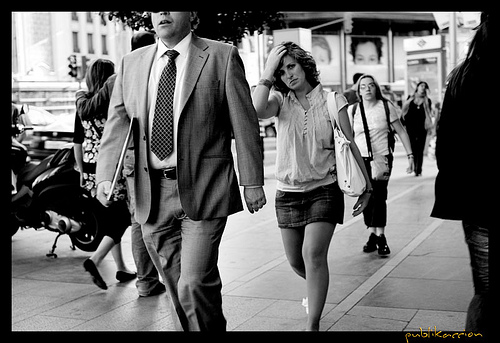The City is Alive
Whether looking to capture the glory of nature, the beauty of culture or a pivotal historic event, all fields of photography are ultimately about finding that defining moment.
Street photographers and wildlife photographers have something important in common: They both observe their subjects in their natural habitat, doing what they do every day, and what may be daily routine for them can produce that critical moment the photographer is looking for (smashingmagazine.com).
Ironically, street photographers may in some cases face greater danger in pursuit of their profession than wildlife photographers. Wildlife photographers tend to observe their subjects from a distance, but street photographers have to get up close and personal with people who may not appreciate it. They have to find the balance between getting the shot they want and staying within the bounds of what people are willing to tolerate. Some are so determined that they use concealed cameras, treading the line between photography and voyeurism.

Defining Street Photography
The art was born on the streets of Paris, during the early twentieth century, with the likes of Eugene Atget and Henri Cartier-Bresson promoting city life as a subject for powerful imagery through photography; a medium that, until then, was seen as little more than an efficient means of producing portraits. Atget focused on the architecture of the city, Cartier-Bresson on its people (Wikipedia).
It was on the streets of New York, in the 1960s and 70s, that the art form truly established itself as a field of photography, thanks to people like Lee Friedlander, Joel Meyerowitz and Bruce Gilden. Some of these pioneers were quite bold, aggressive even in their approach. According to the Guardian, Bruce Gilden had a confrontational style that put him at odds with some of his fellow street photographers, as well as the people he was photographing.
Where the boundary lies between this and other forms of photography has been a subject of much debate. A specific event, such as a carnival, presents a wealth of opportunity for those looking to capture a human moment. But at what point does covering an event cease to be street photography and cross into the territory of photojournalism? Using cultural activity for inspiration similarly blurs the line between street and travel photography.
The field may seem broad, but its practitioners would pinpoint the following as fundamental tenets of street photography: Spontaneity, and minimal interaction between the photographer and the subject. It’s distinct from photojournalism and travel photography so long as the event and the location are not the primary focus.
Tips from Street Photographers
- Observe: People on the street may be in a rush to get somewhere, but you’re not. It’s better for a street photographer to stay in one place for a while and wait for a moment to present itself, rather than be constantly on the move to find one.
- Many street photographers prefer to shoot in black and white, as they feel color distracts from the subject
- Keep it simple: Trying to force too much detail into a shot can often work against it. Rather look for something that can provide a singular focus for the image.
- Look for current trends, things that may not still be around years from now. James Maher believes street photographs carry more weight when they show people engaged in an activity one is unlikely to see nowadays, such as a photo of someone using a payphone.
- Contrary to popular belief, street photography doesn’t always require that people be in the photo. This may seem counter-intuitive, but even an image of an abandoned subway at night can say something profound about everyday human existence.
- Alcohol can be good. No, seriously. According to Eric Kim, street photography may be one of the few jobs where drinking a moderate amount of alcohol beforehand can actually help, as will operating in an area where a lot of people are likely to have done so.
A street photographer seeks moments that could be simple or flamboyant, an instant of normal human interaction or a response to a significant event. What ultimately matters is that it’s a human moment, one that could occur anytime, anywhere. Photography can capture the spirit of adventure or an extraordinary historical milestone, but in the case of street photography, it’s about finding powerful images in everyday human existence.
Matthew Flax lives for the art of photography and takes photography courses whenever he can to keep his skills sharp and his knowledge, courses such as those from Now Learning.
 CoalesceIdeas Web and graphic design ideas for inspiration
CoalesceIdeas Web and graphic design ideas for inspiration




One comment
Pingback: Leesrmvc